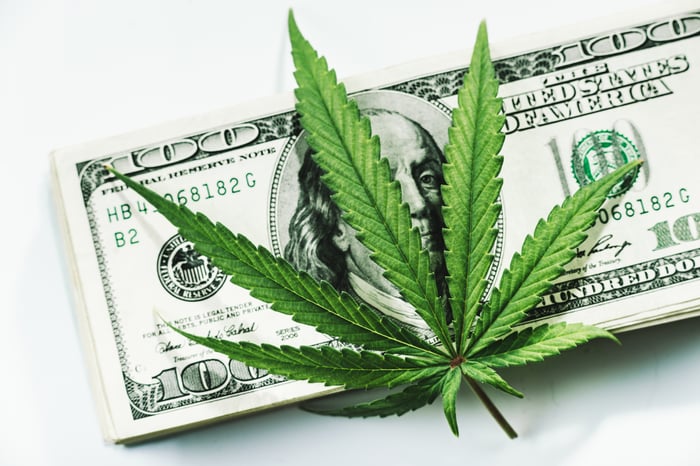Most cannabis companies are reporting losses because they need to invest in marijuana production capacity, product development, marketing, packaging, and distribution to capture their fair share of the $150 billion global marijuana market. Bottom-line profitability for the industry is likely to remain elusive for a while, but Aphria Inc.'s (NASDAQOTH: APHQF) top-tier gross margins suggests it's positioned to be the most profit-friendly pot stock in the future.
Controlling costs
Aphria's annual report mentions "low-cost" eight separate times, so controlling costs is undeniably central to its business model.

IMAGE SOURCE: GETTY IMAGES.
To deliver on its goal to lead the industry in low-cost marijuana production, it relies heavily on greenhouses rather than indoor facilities, and it's investing heavily in automation and other cost-saving technologies to reduce production costs per gram.
Outdoor cultivation is cheaper than greenhouse production, but Canada's climate isn't very cooperative for growing cannabis outside year-round. Indoor cultivation provides more control over production, but it's considerably more expensive than greenhouse cultivation. In 2016, Deloitte conducted a study of marijuana production costs for the Australian cannabis market. It found that producing 11 tons of dried cannabis to meet Australia's expected demand would cost $888, $1,539, and $1,909 per kilogram of dried flower for broadacre, greenhouse, and indoor cultivation, respectively.
Clearly, if your goal is low-cost production in cold-weather climates, then greenhouses are the way to go. Because of this, it's probably not too surprising to learn that 250,000 kilograms of Aphria's expected 255,000 kilograms of marijuana production capacity next year will come from greenhouses, including 110,000 kilograms from its Aphria One greenhouse and 140,000 kilograms from its Aphria Diamond joint venture.
Aphria's focus on costs doesn't end there, though. According to Deloitte, labor accounts for about 46% of greenhouse production costs, so containing labor is critical to driving costs per gram down.
To minimize its labor costs, Aphria's automating the transplanting of cuttings into its final pots for flowering, the evaluation of plant health and quality, water and nutrient use during the growing cycle, and the transportation of plants for processing. The company's also automating its processing operation to include cutting plants; de-budding and trimming plants; disposing of waste from cutting, de-budding, and trimming; and distributing buds into the drying rack for curing.
According to Aphria: "The only human interaction to occur will be at the initial phase of taking the cuttings and throughout the plants' growth cycle, to trim and prune the plants, which will occur in work bays outside of the greenhouse."
Automation isn't the only way it plans to tamp down costs, either. It's also targeting utilities.
Electricity is the second-biggest greenhouse expense, and to keep that spending under control, Aphria's installing a power cogeneration plant at Aphria One to generate electricity for lighting, temperature control, and humidity control. The system will also produce hot water and CO2 to be used during plant growth. Also, the company's putting in a system that recycles the water it uses for plant irrigation, which should keep its water bill in check.
Will these measures work?
Purists will shudder at automated greenhouses and processing facilities churning out marijuana, but technology is so good today that these greenhouses should be able to produce high-quality product and, importantly, produce it consistently at scale.
The at-scale production quality is particularly important as the marijuana marketplace shifts away from dried flower sales to finished products like oils, candies, food, and beverages. As marijuana becomes more of an ingredient in the items consumers buy, consistency, efficiency, and low-cost production are going to be incredibly important.
There's good reason to think that Aphria's money-saving ways are going to reward investors with higher long-term profits than competitors, too. Why? Because Aphria is already generating market-leading gross margins.
After removing the impact of fair-value adjustments due to changes in inventory (which can compromise apples-to-apples industry comparisons), Aphria's gross margin was 75.6% last fiscal year. Last quarter, its cash costs of production, or costs minus packaging and amortization, were $0.95 per gram and its gross margin was a whopping 78.7%.
For comparison, Aurora Cannabis' (ACB 3.95%) gross margin was 65% last fiscal year, and last quarter its cash production costs were $1.70 per gram and its gross margin was 74%. Canopy Growth (CGC 5.31%) doesn't report cash costs per gram of production, but its gross margin was 43% last quarter and it was 52% last fiscal year.

IMAGE SOURCE: GETTY IMAGES.
What about net income?
When these companies mature, operating margin and net income will become the yardsticks that matter most to investors. For now, their sales and gross profit are so small that nonoperational line items are causing their bottom-line metrics to swing wildly.
As an example, the quarterly gains and losses on the investments these companies have made in other publicly traded companies alone can cause their net income to soar or swoon in any given quarter. For example, Aphria's net income was impacted by $11.3 million in gains on marketable securities last fiscal year. It's important to know that's happened, but its impact on Aphria's net income tells me more about how hot the marijuana stock market's been than Aphria's underlying business model. Stock-based compensation is another example. Aphria's stock-based compensation was $17.8 million last fiscal year and its revenue was only $36.9 million. Does stock-based compensation's impact on the bottom line help me understand this company's competitive advantage as much as its gross margin? I don't think so.
Ultimately, cannabis companies are going to need to reward investors with earnings, but until these companies grow up, I think gross margin is more useful to figuring out which marijuana company could be most profitable down the road. As it sits today, that company is Aphria.




